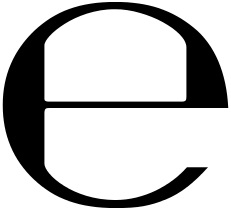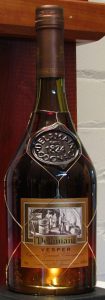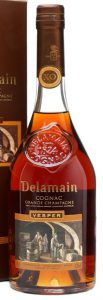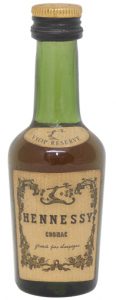- onderschrift
Inhoud:
De inhoud wordt meestal in milliliter (ml), centiliter (cl) of liter (L) weergegeven. Voor flessen die bestemd zijn voor het het buitenland kun je enkele andere inhoudsmaten tegenkomen: fluid ounce (fl.oz.; oz. fl.), pint (pt), quart en gallon. Deze inhoudsmaten verschillen in Amerika van die in de Angelsaksische landen. Voor de Angelsaksische landen wordt imperial gebruikt om het verschil aan te geven met die van de US.
In de UK is een (imperial) fluid ounce 2,84cl. Dit is 1/20e van een imperial pint. Na 1980 word er eigenlijk geen Fl oz of pint meer gebruikt. 24fl oz is gelijk aan 68,16cl.
In de US is een fluid ounce 2,95735296875 cl, afgerond 2,96cl. Dit is 1/16e van een US pint.
Een imperial pint is 56,83cl; 2 pints is een Imperial Quart (113,65cl)
Een US pint is 47,3176473cl (afgerond 47,31cl); ook hier zijn 2 pints gelijk aan 1 Quart (94,6352946cl).
Een gallon (US) is 3,78L
Een UK Gallon is 4,55L
Content
Alcohol percentage
Content:
Usually content is given in milliliter (ml), centiliter (cl) or Liter (L), but other units of capacity can be encountered: fluid ounce, pint, quart and gallon. Unfortunately these have different values in the US and the UK.
UK
1 fluid ounce (floz.) equals 2.84cl and is also called imperial fluid ounce to distinguish it from the US fluid ounce. 1 fl.oz. is 1/20th of a pint or imperial pint.
1 pint is 56.83cl and two pints is equal to a quart or imperial quart. So a quart is 113.65cl.
1 Gallon equals 160 fluid ounces, which amounts to 4.55L. 1 Gallon is 8 pints or 4 quarts.
US
1 fluid ounce (floz.) equals 2.95735296875cl (round off to 2.96cl) and is also called US fluid ounce to distinguish it from the imperial fluid ounce in the UK. 1 fl.oz. is 1/16th of a pint or US pint.
1 pint is 47.3176473cl and two pints is equal to a quart or US quart. So a quart is 94.6352946cl.
1 Gallon equals 128 fluid ounces, which amounts to 3.78L. 1 Gallon is 8 pints or 4 quarts.
| EU | ml | 30 | 50 | 100 | 200 | 350 | 375 | 680 | 700 | 730 | 750 | 1000 | 1500 | 1750 | 3000 |
| UK | fl.oz. | ~24 | 26.4 | ||||||||||||
| US | fl.oz. | 25.36 |
1 imperial quart (UK): ~113.65cl
4/5 quart (US): ~75.71cl
1 US quart: ~94.63cl.
0.945L (eu): 1 quart (US)
24 fl.oz (UK): ~68.16cl
26 fl.oz (UK): ~73.84cl
6 pt 12 fl.oz. (3.78L) ???? 6pt = 2.84L en 12 fl. oz.= 35.5cl dus samen 3.19L
0.027L= 27ml
0.029L=29ml: ~1 US fl.oz
2 3/4 fl.oz = 7.81cl
1/16 US pint = 2.96cl
1fl oz, 28ml
43ml =
25ml =
In Europa is de standaard flesinhoud voor sterke dranken 70cl (voor wijnen 75cl). In Amerika is het 75cl (750ml).
Voor Amerika zijn de volgende inhouden verplicht vanaf januari 1980: 50ml, 100ml, 200ml, 375ml, 500ml (verboden voor flessen na 1989), 750ml, 1000ml en 1750ml.
Voor Europa zijn de volgende inhouden verplicht vanaf januari 1990 (of misschien vanaf 1992): 100ml, 200ml, 350ml, 500ml, 700ml, 1000ml, 1500ml, 1750ml en 2000ml.
Voor 1990 was het niet ongebruikelijk in de UK om 68cl flessen te hebben in plaats van 70cl.
Ook 73cl flessen kwamen nogal eens voor, maar daar zat dan wel weer 75cl in. De producer wilde niet het risico open om minder cl in de fles te hebben dan het label aangaf.
Alcohol:
Alcoholpercentage is in Europa de verhouding alcohol tot water op 20°C.
In Frankrijk werd vroeger veel de Gay-Lussac waarde gebruikt. Dat is ook de verhouding alcohol to water, maar dan 15°C.
In de UK wordt Proof gebruikt (afwijkend van Proof in de US). Om proof om te zetten naar alcoholpercentage moet je het met 4/7e vermenigvuldigen. Dus 70 proof is 4/7*70=40 procent.
In de US komt 1 proof overeen met 0,5°. Dus 80 proof=40°alc.
The following information can be found on labels
Content
Denomination under which it is sold (Cognac)
Brand name
Additional name
Name of a person within the distributional network (importer)
Vendor and vendors address
Producer
Content
Alcohol percentage
Cotisation symbol
Excise-duty symbols (HKDNP; Hong Kong duty not paid and other excise-duty statements (Duty Free, duty not paided, etc.)
Recycling symbol (na 1994)
Französisches Erzeugnis
Early Landed
Healt message symbol (pregnants; since 2006)
‘e’ in front of (or after) content: estimated sign. Standardized to look precisely as: 
echantillon gratuit
Paper top seal to warrant autenticity and prevent fraud
Ageing designations
Cru, regional appellation
Fine
Medailles
Escutcheons
Royal or Imperial appointments
Denomination.
It is required to state on the label that the content is cognac. If you can not find the word ‘cognac’, you can be sure the bottle does not contain real cognac. An exception can be made for some very old bottles, before the Second World War. These bottles can have the brand name stated only, or are called brandy.
Younger bottles that say brandy, are not real cognacs.
Brand name.
The brand name is always on the label. It is not necessarily the same name as the producer. The name of the producer is sometimes not mentioned on the label, for instance for some supermarket chains that like to sell cognac under their own name.
Additional name.
Sometimes a bottle is worthy to get its own name. They are sometimes called after names of relatives or they have beautiful poetic names.
Name of person within the distributional network.
Bottles are sometimes imported by companies in such great numbers, that they have asked to have their name and address stated. They are not necessarily the vendor. It can be stated as the firm that imported the bottle or even the firm that has bottled the cognac.
Vendor and vendors address.
More or less the same as menioned above for persons within the distributional network.
Producer.
The name of the producer is usually mentioned as is his address. This is not however obligated. Very often it is printed at the bottom of the label. Sometimes on the back-side of the bottle.
Content.
It is obligatory to state the content of the bottle. This may be done in milliliters, centiliters or liters. On older bottles it could be mentioned using fluid ounces, quarts or pints, either in Imperial (UK) or in US measures. More on fluid ounces, quarts, pints and gallons in a separate paragraph below.
Estimated sign
The estimate sign is the letter ‘e’ standardized to look exactly like this:
It certifies that the contents of the bottle comply with certain criteria that are specified, especially that the content is not less than the nominal quatity that is stated.
Alcohol content.
The alcohol content is also obligatory on cognac bottles. Except for some rare exceptions it is always at least 40°. It must be stated in percentage of alcohol by volume. On older bottles you may find Gay-Lussac or Proof.
Gay-Lussac is roughly the same as alcohol by volume. 1 Proof is in the US a half percent of alcohol by volume. So 80° proof is eaqual to 40°alc/vol. In the UK it is 7/4 of alcohol by volume. So 70° proof is 40° alc/vol.
Ageing designations
They are not required. They give information about the number of years a cognac has been stored in wooden casks before it was bottled. Some ageing designations are controlled by the BNIC, so the buyer has a warrant that the cognac is at least as old as it says it is. These are VS, VSOP, Napoléon and XO.
If there is no age indication whatsoever present, you can safely assume that the cognac is as young as a VS.
Other designations are not controlled by the BNIC. There exist well over a hundred of them. Some that are often used are: ‘de luxe’, ‘spécial’, ‘supérieur’, ‘vieille’, ‘vieille réserve’, ‘réserve de la famille’, ‘héritage’, ‘hors d’age’. They all correspond with a minimum number of years of the official designations, but are usually substantially older. But you have to believe the producer on this, because there is no official check.
Cru
The cru indicates from which region the cognac originates. There are six different cru’s and each cru corresponds with a certain quality. They are, in order of quality: grande champagne, petite champagne, borderies, fins bois, bons bois and bois ordinaires. If ‘cru’ is stated on the bottle it means that all of the cognac originates from that cru. A ‘blend’ is the opposite of a ‘cru’. A blend cognac consists of cognacs of different cru’s.
Notweworthy is the term ‘fine champagne’. It is not really a cru, but it means the cognac is mad out of grande champagne and petite champagne only, and at least 50% grande champagne. It is not to be confused with ‘fine cognac’, which has no other meaning than to say it is ‘good cognac’, for wathever that is worth.
Appellation Controlée
Appellation Controlée is a descition to guarantee the cognac was produced in the specified region. So you can have ‘Appellation Cognac Controlée’, but als in combination with the cru: ‘Appellation Fins Bois Controlée’. There is one acception: the last cru (bois ordinaires) is the only cru that not has the right to bear an appellation controlée specification. ‘Fine champagne’ on the other hand, does have this right.
Fine
Fine can be used in combination with the word cognac, or in combination with a cru-name. The first possibility does not have any real meaning other than to say it is ‘good’ cognac. In combination with a cru-name however, it is a guarantee the cognac originates from the specified region (cru).
Early landed
It has long been a custom to ship cognacs to England very soon after distillation. Here they were stored for decades in damp cellars near the shores. These cognacs are called ‘early landed’. Since some years now, this is forbidden by the French law. To have the right to call it cognac, they are required to age in the region where they originte from.
Logo or emblem
Almost each brand has its own logo or emblem. It can be in the way the name is written, or it can be a picture of something characteristic to the brand or the owner. It serves as an eye-catcher, so the buyer can easily recognize the bottles of his favorite brand. It can be a picture of the house, a picture of a person, a coat of arms or an allegorical image.
Medals
Cognac producers often participate in competitions where several cognacs are compared to each other. There are prizes to be won, usually bronze, silver and gold medals. These medals are sometimes depicted on the label or are represented by a seperate sticker on the bottle.
Royal or imperial warrants
Some producers have had the good fortune to receive a royal or imperial warrant, meaning they were choosen to supply their products to the royal or imperial court. It is a recognition by the royal or imperial family of the outstanding quality of their products. With this recognition they earned the right to portray the royal arms or the imperial arms on their products.
Cotisation Securité Social symbol
The cotisation symbol has been used betweeen 1984 and 2000. It indicated that tax was payed to counter the health risks involved in immoderate use of the product. Also known as ‘vignette sécurité sociale’ (VSS).
Excise-duty symbols
HKDNP = Hong Kong Duty Not Paid
Paper seal
A paper sealing of the capsule is used to prevent fraudulous actions and tampering and to warrant the autenticity of the product.
They can also be tax stamps.
Französisches Erzeugnis
Stating that the product was produced in France. Used on bottles that were sold in Germany.
Ausländisches Erzeugnis
Stating that the product was produced abroad. This is of course only used on bottles that were sold outside Frace, particularly in Austria.
Recycling symbol
This started after 1994. Widely used is the Mobius loop. It only indicates the object is capable of being recycled (first created in 1970 for World Earth Day).
Tidyman symbol
Reminder as to dispose of the material toughtfully, like a good citizen.
Tidyman glass symbol
a reminder to throw the glass container in a bin.
Green Point
This symbol only means the producing company has contributed financially to recycling processes.
Healt message symbol
Warns pregnant women not to consume the product (since 2006).
Échantillon gratuit
This means so much as a ‘free sample’. Usually printed on a miniature bottle that was produced as a give away to make the public acquainted with the product.
Milliliter, fluid ounces and more
Usually content is given in milliliter (ml), centiliter (cl) or Liter (L), but you come across other denominators: fluid ounce, pint, quart and gallon. Unfortunately these have different values in the US and the UK.
UK
1 fluid ounce (floz.) equals 2.84cl and is also called imperial fluid ounce to distinguish it from the US fluid ounce. 1 fl.oz. is 1/20th of a pint or imperial pint.
1 pint is 56.83cl and two pints is equal to a quart or imperial quart. So a quart is 113.65cl (rounded off to 114).
1 Gallon equals 160 fluid ounces, which amounts to 4.55L. So 1 Gallon equals 8 pints or 4 quarts.
1 Gallon = 4.55L
1 Quart = 1.14L
1 Pint = 56.8 cl
1 Fluid Ounce = 2.84cl
US
1 fluid ounce (floz.) equals 2.95735296875cl (rounded off to 2.96cl) and is also called US fluid ounce to distinguish it from the imperial fluid ounce in the UK. 1 fl.oz. is 1/16th of a pint or US pint.
1 pint is 47.3176473cl and two pints is equal to a quart or US quart. So a quart is 94.6352946cl (rounded off to 94.6 or 95cl).
1 Gallon equals 128 fluid ounces, which amounts to 3.78L. So 1 Gallon equals 8 pints or 4 quarts.
1 Gallon = 3.78L
1 Quart = 0.95L
1 Pint = 47.3 cl
1 Fluid Ounce = 2.96cl















